re-imagining the built environment for a sustainable future
Don't wanna be here? Send us removal request.
Text
The Liberal Perspective
The way I see it, one of the main differences between liberals and conservatives is the idea of personal responsibility. A conservative believes that individual hard work and dedication are the main ingredients necessary to achieve success in life, and that money and material comforts are personally earned rather than freely handed out. Wealth is therefore a measure of talent, willingness to take risks, perseverance in attaining goals, and most importantly, good old sweat and hard work.
Simply put, conservatives believe that they are personally responsible for their successes and failures in life.
From the liberal perspective, these ideas certainly have merit and we agree with overall idea, which is that hard work should be rewarded, and that the harder you work, the more you should earn. Of course someone who works hard should be rewarded with a good job and a high standard of living, while someone who spends all day lazing around ignoring their studies should not live in a mansion and drive a Rolls-Royce.
But liberals see an additional layer of nuance that is not usually part of the conservative point of view. Liberals put individual successes and failures into the larger social context. From the liberal perspective, no one earns 100% of what they have. There are many reasons for this (which I will describe in more detail below) but one is simply that people’s successes build upon the achievements of millions of other people, upon the accumulated wealth of an advanced civilization which developed for thousands of years before they were born, and therefore cannot be claimed as solely the product of their own efforts.
Conservatives believe that nothing is handed out for free, but in fact, each of us, at the moment we are born, becomes a part of some existing socioeconomic environment, and is handed the collective wisdom and achievements of billions of people who have lived, worked, and died before us.
With this idea, I am just trying to introduce the concept that no one can say that they personally earned everything they have in life, because we all rely on the collective achievements of everyone alive today and everyone who has come before us. We live in an advanced civilization that is several thousand years old, a civilization that has discovered how to release the energy of individual atoms, send rockets beyond the edge of the solar system, and edit our own DNA. We should, at least on some level, acknowledge this free gift we were handed. I’m not saying we need to thank Newton and Einstein each time we use the GPS to find a new restaurant, but to at least have an appreciation for the fact that all of our personal comforts come from the labor and talent of millions of other people.
The points I made above are a bit “out there” and probably more profound than what an everyday liberal would usually be thinking about. At a more concrete level, though, the basic idea is the same. We rely on the frameworks and structures of civilization in order to achieve success in life. An important category of products and services we rely on are those funded by the government through taxation. These include roads, bridges, ports, dams, electrical grids, the patent office and copyright protection laws, police departments, fire departments, the military, the EPA, the USDA, the FDA, the consumer financial protection bureau, financial regulations, PELL grants, laws enforcing business contracts, bankruptcy laws, traffic regulations, the court system, FEMA and other disaster management and aid programs, the CSB which investigates industrial hazardous chemical emergencies, and on and on. Many conservatives complain of big government, but these services are here to create an environment where individual people can build a successful life, and should be thought of as programs paid for by everyone, for everyone. They provide a supporting structure which we all rely on, whether we realize it or not, to build our wealth and happiness.
The majority of liberals, including myself, favor a capitalist economy, so I will not spend any time arguing for other economic systems. Therefore, we generally agree that the mixed economy that we have now (a free market with some government intervention) works well, and that this is a good model for setting prices and exchanging goods and services.
To a liberal, though, there are very important limitations that must be placed upon our capitalist system in order to make the society that it produces “fair.” Chief among these is the problem of wealth accumulation. This is a serious point of disagreement between liberals and conservatives, so I will look into the issue closely.
I have made two major points so far: (1) capitalism is, in general, a good system for society to be organized around, and (2) no one fully earns 100% of what they have, because they relied upon (a) the previous generations of people who built up society to what it is today, and (b) the frameworks and structures of that society, including the services of government collectively paid for by everyone. The result is that we are all very tiny elements in a vast, interconnected, interwoven society of hundreds of millions of people, with any one person in this system very much relying on everyone else to achieve a comfortable life. This collective effort is central and essential. We are a social species, after all.
Because of the inter-reliance and cooperation built into this system, a liberal would see it as unfair if any one person pulls too far ahead of the pack in terms of the wealth they have obtained in life. The vast majority of Americans, for example, make less than $250k per year. Although this is definitely a large number, let’s call an annual income of less than $250k “normal,” and let’s assume that these incomes are proportional to effort. By “proportional to effort” I simply mean that someone who works twice as hard makes roughly twice as much money, someone who works three times as hard makes three times as much money, and so on.
This is of course hard to measure and very subjective, but I think that many people (including both liberals and conservatives) would accept the premise that people who earn $250k are more talented and have worked harder, and therefore have earned and “deserve” that higher income, and that a person who earns $40k is still making enough to make ends meet, but may lack similar work ethic, talent, and skills. Additionally, this difference in incomes is an important motivating force in the capitalist system, compelling people to work harder (and therefore make more contributions to society as a whole) in order to make that higher income.
The problem comes when individuals start accumulating wealth that far exceeds their efforts compared to everyone else. Simply put, is a man earning $50 million per year really working 1,000 times harder than someone earning $50k per year? Even if conservatives have other reasons for supporting the ability of people to make such large incomes, I think that, if pressed, they would agree that, no, he is not really working 1,000 times harder than the average Joe.
Does he deserve to have a large income? Definitely. He is making very important contributions to society, whether by managing a company that sells life-saving pharmaceuticals or one that manufactures essential agricultural equipment. Whatever it is, he is providing some socially-useful product or service which people are paying for, and the capitalist economy is rewarding him for his work.
But there is no reason to assert that he should individually keep such a large fraction of the profit of the company he manages, nor is it objectively true that he “earned” or “deserves” it. You see, the capitalist system we have chosen is entirely a product of the imaginations of human beings, and everything about it sprouted from the minds of ordinary men and women. The capitalist system is not a “law of nature” or some profound “universal truth.” It is a man-made entity, and all parts of it are arbitrary. Yes, it is a very good system as we have devised it, but no, just because a CEO makes $50 million in the capitalist system does not mean that most people would agree it is fair for him to keep that amount.
Liberals see it as an unfair accumulation of wealth, simply because we think that it is not possible for any person to truly earn $25,000 per hour in a country where poverty, homelessness, lack of access to basic health care, and other societal problems still exist. In our view, he is not working 1,000 times harder than the average person, and we do not believe it is justified that he should rise so significantly above the rest of the society which supported him in the first place.
Moreover, to even be in the position of earning that amount means that this CEO is relying more heavily on the institutions of government and society than the rest of us, whether through the patent and copyright office which is protecting his intellectual property with taxpayer dollars, to the highway system which distributes his goods to all corners of the country, to the FDA which makes sure that his products are safe so that consumers have the confidence to buy them. Somehow, his ability to accumulate wealth has become decoupled from the notion that working harder leads to a proportional increase in success. Liberals believe that this should be rectified.
And so we come to the idea of taxation. Everyone is taxed to pay for government services, as we know. The general view is that, on average, we should raise about 20% of the GDP in taxes to pay for all of the services necessary to generate that GDP. Liberal policies often lead to higher taxation (which I will explain more below), so let’s say that amount is 25% for a liberal government.
We then simply assert that the tax system should be devised in such a way that taxes are paid on the basis of one’s ability to pay. The less one makes, the less one is benefiting from the services of government, and therefore the less one pays in taxes, and vice versa. This distribution of taxes naturally pushes the tax burden on higher income brackets, with the wealthiest people paying the highest marginal tax rates. This is not a punishment to wealthy people, it is an inevitable and necessary outcome of a system in which taxes are paid on an “as-able” basis. Poor people do not become rich off this system, and rich people remain rich after their taxes are taken. There are no massive redistributions of wealth in this setup, and everyone’s after-tax income remains proportional to their effort and level of hard work.
And for the very wealthy, like the CEO making $50 million, his after-tax income may fall to $20 million. A $30 million drop!? Well, yes. He had more of an ability to pay, and so he has been taxed more. And, very very importantly, this has (from the liberal perspective) improved the proportionality between his effort and his income. It is at least more reasonable to assume that he deserves closer to $10,000 per hour for his effort, rather than $250,000, and that he works closer to 400 times harder than the average Joe, rather than 1,000 times harder. Of course, it is still hard to imagine he is working that much harder, but we are not trying to completely re-write the rules of capitalism.
We are content with this modification allowing for more reasonable incomes among the very wealthy, and a better proportionality between their incomes and the level of effort with which they work compared to average workers.
That’s it. That’s the core of the liberal perspective concerning wealth accumulating and taxation. It is about acknowledging that capitalism works well, but in the realm of very high incomes it becomes necessary to make modifications, through tax policy, to achieve a fairer economic outcome that helps to ensure that the income vs. effort proportionality does not diverge so significantly from the rest of the workforce.
This has the added benefit of allowing this additional tax revenue to go toward other social programs, the most important of which is universal health care. The liberal view of healthcare is very consistent with the philosophy outlined above about fair outcomes for everyone. Unexpected disasters happen in life, and the premise of universal healthcare is to give everyone the peace of mind that if they are the unlucky victims of such events, they will never have to worry about going bankrupt or selling their homes in order to pay their medical bills.
3 notes
·
View notes
Text
Society
Let’s talk about society. What is “society?” It’s a group of people who depend on each other to achieve their goals. The most basic life goals are simply to stay alive; have food, water, shelter, and clothing for your family; raise kids in a stable environment; have time for leisure; and to be protected from crime and violence. Another important thing in life is freedom, which is basically the ability to do what you want. These are the things everyone wants.
Of course, one way to live is the “survival of the fittest” approach, in which each person is out for themselves. In this kind of world, the man of the house would do whatever he needed to do, from stealing to murder, to protect his family and to secure food, water, shelter, and clothing. Of course, no one will get food for him or make clothing for him, so the family has to do that stuff themselves. And if a stronger family comes along and fancies their plot of land, they’ll just kill them and take it for themselves.
Obviously, human nature isn’t like this. At some point a long time ago people figured out that they’d have a better chance of staying alive and achieving their goals if they cooperated and didn’t kill each other. They divided their labor, with some people growing food and other people making clothing and other people building canals to irrigate the fields and other people making tools, etc. And they either imprisoned or executed people who broke the laws of cooperation they had set up for their society.
Hundreds of years passed, yaddah yaddah yaddah, and eventually we structured our society into a capitalist system where people earned and spent a handy little tool called “money.” Money is essentially just a sheet of paper with a certain number of “cooperation points” printed on it, which says how much someone needs to cooperate to society in order to earn it.
If Ernie goes and cuts some trees down, spends several months of his life carefully chopping them up into nice evenly-sized pieces of wood, and bundles them up for sale, Ernie has done a service for society. He “did his part” in cooperating with everyone else. Now nobody else has to chop up wood for a while. This is especially useful for people who are old, sick, or disabled, who would not have been able to cut up the wood themselves.
When someone at the market gives Ernie $50 for a bundle, they’re saying “Thank you for chopping up this wood! You earned about 50 cooperation points in society. Now I’ll give you this sheet of paper which says that you deserve something of equal value from someone else.” And so Ernie will go buy a month’s supply of grain from farmer Frank, who will accept the $50 bill because he knows Ernie earned it by contributed meaningfully to society in some way.
And so society goes on, with people producing and selling goods and services to others. Everyone relies on each other. Betty the baker cooks her apple pies using Andy’s apples and Warren’s wheat, while Barney the blacksmith, using the hammers he bought from Hank, creates the plows for Warren’s fields using the iron from Martin’s mine.
It is in everyone’s best interest that everyone else is able to do their job well. Otherwise, the interconnected economy will begin to suffer. And there are certain elements of the society that should be extra protected from the ebbs and flows of the economy. For example, suppose this society is located in the middle of Idaho, where not enough rain falls to water the crops. Therefore, canals are essential. Without them, the food supply would collapse. But the canals are too expensive for any one company to build. Therefore, everyone in town contributes to paying for the system of canals to be built and maintained.
But there are problems that can arise in this capitalist system. Suppose there is a company called Ned’s Shoes, owned by Ned, who employs 50 people. The company sells shoes, and their shoes are very popular. In fact, their shoes are much more popular than those sold by any other shoe company, including Ted’s Shoes, who also employs 50 people. Ned’s Shoes makes $100 million per year but Ted’s Shoes (and all other shoe companies around the country) make $5 million per year.
Ted makes $2 million per year, and each of his 50 employees makes $60k per year. Meanwhile, Ned makes $96 million per year, and each of his 50 employees makes $80k per year. Ned, being the CEO, can set his salary this high because he owns the company. However, the reason his company is so successful is actually due to the hard work and innovative new ideas that his employees came up with. But they won’t complain, because they’re still making more than the other shoe company workers.
The issue here is this: someone (Ned) is using the framework of society (organized wage labor) in a way that is enriching himself in a way that most other people would consider “unfair.” It’s his employees who are the real source of innovation and hard work, but they are not getting the proper amount of money which reflects their contribution to society.
Moreover, Ned is making more money than he can reasonably spend. When society as a whole needs money (to build a new railroad, for example) it is only natural to look to Ned first, who has amassed an unfair amount of money.
Everyone is better off in life when their whole society is doing well. The food supply will dwindle if the farmers get sick or injured, so there’s a need for medical services to bring them back to health. In a high-tech society the next generation won’t be able to maintain their
That way, they make sure that people don’t lose their ability to cooperate for too long.
1 note
·
View note
Photo
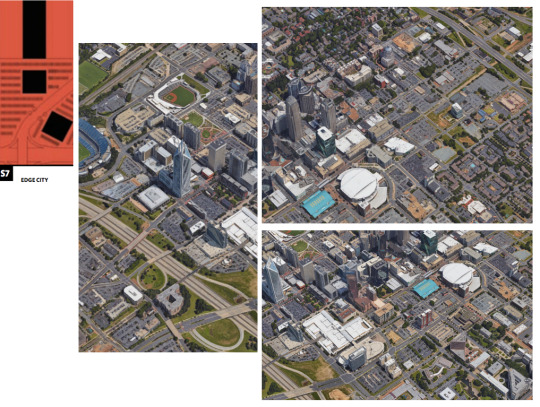
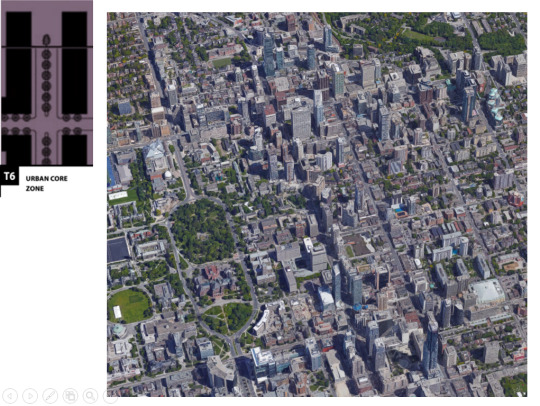

The Levels of Traditional Urbanism: Part 1 of 4 - Urban Core Zone
In this series of posts, I will contrast the various levels of sprawl with those of traditional urbanisms. From least dense to most dense, the zones of traditional urbanism (proposed by Galina Tachieva in her book “Sprawl Repair Manual”) are: (T1) Natural, (T2) Rural, (T3) Sub-Urban, (T4) General Urban, (T5) Urban Center, and (T6) Urban Core. I will only post about T3 to T6 because my focus is on the design of cities more so than the surrounding countryside. In each post, I will include one or more images to illustrate the corresponding sprawl development pattern (as explored in more depth in a previous series of posts) - although there is not a clear one-to-one correspondence between the levels of sprawl and the levels of traditional urbanism.
7/31/2016 ~ We will begin by looking at the Urban Core Zone. The second image above is a satellite view of downtown Toronto, Ontario. Compared to the Edge City of Charlotte, the almost complete lack of surface parking lots in Toronto is striking. It is this feature that most clearly distinguishes the urban fabric of the two cities and gives each of them a distinct character. Granted, Toronto is a much larger city than Charlotte and it makes sense that its urban core would be larger and more prominent from above.
However, a closer look at areas farther from the city center (not visible in the image) shows that Toronto in fact does not have an Edge City zone at all. Nowhere in Toronto or its surroundings are parking lots a dominant feature of the landscape, nor do multi-lane highways separate the city from its residential areas. This can be seen in the third image, where density increases from left to right (albeit over a relatively short distance to provide a well-defined - rather than sprawling - downtown district) and no artificial boundaries or vast expanses of concrete and asphalt separate land uses - which is a central theme of sprawl developments. The different levels of density are seen coexisting side-by-side.
The essential point here is that the densest part of downtown, where the tallest buildings and most important civic spaces are located, is seamlessly integrated into a larger urban zone, with a well-connected gridded street pattern and sufficient transit connectivity to allow easy, safe, pleasant, and fast movement of people (by foot, bike, bus, light rail, commuter train, etc.) to accomplish most of their daily needs without the need of a personal automobile. This increases the economic productivity of the region by not allocating excessive tracts of land for parking, and makes the downtown a more vibrant and interesting place to visit.
1 note
·
View note
Link
0 notes
Text
The Epitome of Sprawl
The Houston metro region is larger than the state of New Jersey.
0 notes
Link
0 notes
Quote
Urbanism is essentially a matter of public spaces, plot sizes and number of floors. There are specific types, dimensions, ratios, and numbers that allow us to build harmonious cities and others that inevitably lead to suburban sprawl, commercial strips, and/or metropolitan congestion. There are forms of high-risk mega-development that produce mega-profits and mega-failures. There are others based on individual talent and enterprise that stimulate civilized competition and lead to humane and agreeable towns. The traditional city performs the miracle of allowing contrasting and competing ambitions, the most modest and greatest of talents to strive and thrive as neighbors; to build in harmony. That is the definition of urbanity and urban civilization.
Leon Krier, The Architecture of Community (via jrenglish)
5 notes
·
View notes
Quote
By 2017, the City of Portland will have experienced a net positive return on investment in its bicycle infrastructure of $500 million in healthcare savings and $200 million fuel savings.
Gotschi, Thomas. Costs and benefits of bicycling investments in Portland, Oregon. Journal of Physical Activity and Health, 2011,8 (Suppl 1), S49-S58.
via oregon metro regional active transportation plan, aug. 2013 draft, pg.19.
(via citymaus)
485 notes
·
View notes
Video
vimeo
Is it weird that a bicycle-friendly intersection design schematic gets me so excited? I hope this (and the whole urban fabric that it facilitates) will be the wave of the future. Dank je wel Nederland!
2 notes
·
View notes
Photo
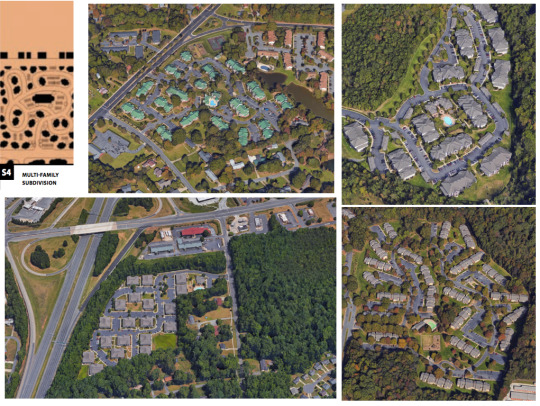
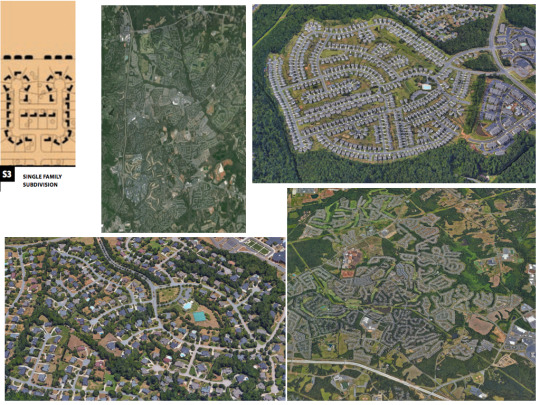
The Levels of Sprawl: Part 4 of 4 - Multi- and Single-Family Subdivisions
7/29/2016 ~ Much of the built environment is comprised of residential areas, either in the form of multi-family subdivisions (apartments, townhouses, etc.) or the single-family subdivisions that come to mind when someone says suburbia. Unlike the Edge City, Business Park, and Shopping Center levels of sprawl, which were inherently ill-designed because of excessive surface parking and large spacing between buildings, the downfalls of multi- and single-family subdivisions can mainly be attributed to the winding layout of the streets and their lack of connectivity to non-residential areas.
Consider the apartment complexes pictured in the first set of images. In all cases, parking is provided in the form of parking spaces that surround the buildings. Again, the metaphor of islands in a sea of asphalt comes to mind, although the case is less severe here than for other sprawl patterns. The bigger issue, however, is that the inner street network of the apartment complex is funneled down to a single entrance/exit point that often exits onto a multi-lane highway or other busy thoroughfare, with little or no alternative ways to access the site. The complexes are often located where walking or biking to shops and restaurants is not a realistic option. Rarely could children living in such places walk to school. Thus, the residents become utterly dependent on their cars to do almost anything.
Similarly, the typical single-family subdivision or “neighborhood” (although I prefer to reserve that word for a mixed-use, vibrant community center) suffers from a lack of connectivity to non-residential districts and often has only one or two points at which to enter or exit the site. Traffic is funneled to a few bottleneck points, and once on the road, a relatively long commute (longer than one would be willing to walk or bike) can be expected before reaching a non-residential area for shopping and entertainment.
Moreover, the cul-de-sac street patterns of single-family subdivisions necessarily cause the neighborhood to consume more land area than the same number of houses would with a more fine-grained gridded street pattern. A gridded street pattern, combined with several access points to nearby multi-use districts, town centers, or transit options (like light rail) to such places, would go a long way toward transforming these mono-functional residential “pods” into a vibrant traditional neighborhood.
The concepts discussed here are based on the ideas presented by Galina Tachieva in her book “Sprawl Repair Manual.”
#urban sprawl repair planning suburbia walkable car dependent built environment complete street#mixed use neighborhood sustainability mass transit oriented development
2 notes
·
View notes
Photo
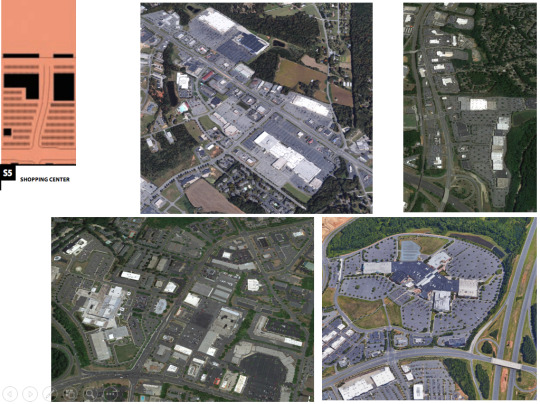
The Levels of Sprawl: Part 3 of 4 - Shopping Center
7/27/2016 ~ Once again, the shopping center enclave is characterized by a landscape dominated by parking lots. Each establishment greedily hoards its parking spaces, and heaven for bid should two adjacent fast food restaurants share their parking! Such a suggestion would not only be blasphemy to the wayward urban planner, since it would reduce the total number of parking places blanketing the region and thus reduce its value as a Shrine to the Holy Car Gods, but it would in many cases be downright illegal due to widespread American zoning codes and ordinances.
Excuse my rant just then. I got a bit carried away...
These shopping centers, largely consisting of strip-malls, rows of fast food restaurants, and big-box stores like Walmart, are disconnected from any semblance of a traditional urban fabric. An attempt to access these places via bike or foot would be a nightmarish fight against traffic, and should one be lucky enough to find a bike rack, the journey would not be complete without a trek across a football field-sized parking lot. Some may assume that people seen walking around such places are probably not casual shoppers on an afternoon stroll to the shops, but rather either homeless, criminals, or children of less-than-attentive parents - a perception that further weakens the strength of the region as an element of a complete community.
See my previous post on Business Park zones for some preliminary ideas of how to combat the negative effects of sprawling developments such as the shopping centers shown here.
The concepts discussed here are based on the ideas presented by Galina Tachieva in her book “Sprawl Repair Manual.”
#urban sprawl repair planning suburbia walkable car dependent built environment complete street#mixed use neighborhood sustainability mass transit oriented development
2 notes
·
View notes
Photo
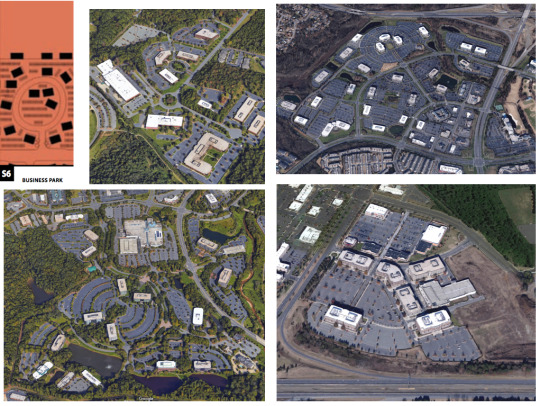
The Levels of Sprawl: Part 2 of 4 - Business Park
7/27/2016 ~ In much the same way as the Edge City zone, the Business Park level of sprawl is predominantly characterized by its over-abundance of surface parking and the practical inability to access the site via any mode of transportation other than the car. From the satellite images above, it is easy to compare the office buildings to islands in a sea of asphalt, with the adjoining multi-lane highways and arterial roads not only flowing into them, but also physically separating them from nearby areas. The thought of walking to a nearby restaurant during lunch break would be laughed off as absurd by your co-workers should you every have such an outlandish suggestion! Instead, you all jump into your cars to cross the road in what would have been a 5-minute stroll.
The land area consumed by these business parks could have been drastically reduced by placing the buildings closer together and then building a single parking deck (better yet, putting the parking underground). But this approach itself would not alleviate two of the most serious symptom of sprawl, which are (1) the extremely high level of dependence on personal automobiles, and (2) the inability to reasonably access other types of destinations (grocery store, pharmacy, bakery, coffe shop, post office, restaurants, housing, etc.) within a short transit time by foot or bike. I will return to this point in more detail in a future post, but it is absolutely critical that developments have a mix of uses and do not exist as stand-alone, mono-functional, single-use enclaves separated from “real” city or town centers by long highway commutes.
Rather, the office buildings pictured here should be incorporated into a town center with extensive transit connectivity to other such town and city centers, provided (depending on the distance) by protected bike lanes, dedicated bus lanes, light rail lines, and/or commuter rail. In this way, the office workers have more options for lunch within a short walk or bike ride from work, local retail (like restaurants, stores, etc.) have a reliable client base, workers living nearby would not be required to take a car to work in the way that modern development patterns do, and (perhaps most importantly) the urban fabric becomes enriched by the diversity of its population.
The top right picture, which in my view is the most egregious of the four, is described more fully in a previous post, where I sketched a possible way to transform the bland business park into an element of a much more pleasant, livable, economically-stimulating, interesting, environmentally friendly, and vibrant community. Thanks for reading!
The concepts discussed here are based on the ideas presented by Galina Tachieva in her book “Sprawl Repair Manual.”
#urban sprawl repair planning suburbia walkable car dependent built environment complete street#mixed use neighborhood sustainability mass transit oriented development
2 notes
·
View notes
Photo
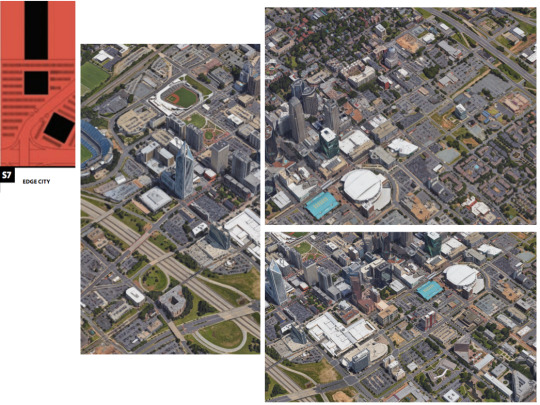
The Levels of Sprawl: Part 1 of 4 - Edge City
7/27/2016 ~ In the following series of posts, I will describe and give examples of the levels of sprawl that are characteristic of most modern American communities. These classifications, which were developed by Galina Tachieva in her book “Sprawl Repair Manual”, divide the sprawling development patterns of car-centric urban areas and their surroundings into seven distinct zones, from least dense to most dense: (S1) Rural Farmland, (S2) Rural Sprawl, (S3) Single Family Subdivision, (S4) Multi-Family Subdivision, (S5) Shopping Center, (S6) Business Park, and (S7) Edge City. Restricting attention to the urban classifications, I will only cover S3 to S7. Throughout these posts, the recurring theme will be the over-reliance of the majority of the population on personal automobiles to get even the most trivial daily tasks accomplished. I hope to vividly illustrate that our built environment is overwhelming constructed to serve the automobile, not the pedestrian, and that in most places walking or biking is not only unpleasant and difficult, but oftentimes dangerous or even impossible.
(S7) EDGE CITY ~ I will start with the Edge City zone, the most dense classification (in terms of people per square mile) of the seven levels of sprawl. The images above show Uptown Charlotte, North Carolina. The #1 feature that distinguishes an edge city from a more traditional urban center is the sheer number of parking decks and surface parking lots. The edge city, as its name suggests, surrounds a more traditional urban core or central business district, seen here as several blocks of densely packed sky-scrapers. This urban core is not sprawl and would not classify as S7. Rather, it is the area surrounding and immediately adjacent to that central business district, with an overwhelming fraction of its land devoted to parking structures, that constitutes the edge city.
In many cases, as shown here, the edge city is larger than the urban core itself. Moreover, it is very often bounded by a multi-lane highway (variously referred to as a belt-line or inner-loop) that serves not only as a physical barrier around the city, limiting easy access for bikers and pedestrians, but also as a mental or psychological barrier that tells people (even people who live just on the other side of the belt-line) that “getting to the city is too hard”, that “the city is far away”, that “my kids are going to get hit by a car if they walk there”, etc.
In other words, the edge city forms an unpleasant, pedestrian-hostile, asphalt-covered wasteland separating what could very well be an extremely nice downtown district from the vibrant neighborhoods just outside the city. Such development patterns discourage the movement of people to and from the city; when people do go to the city, they have little choice but to do so via car (no matter how close they live), which means they must find and pay for parking - not something many people are eager to do.
Thus, like an amusement park, the urban core becomes (for most people) more of a “fun and cool” place to visit once in a while, with its sprawling edge city serving primarily as their parking lot. Most of the shops and restaurants found sporadically within the edge city are primarily visited by people working in the urban core. Urban centers “strangled” by an edge city (which are themselves strangled by the surrounding highway) are therefore not likely to be readily accessible or even desirable to (in Charlotte’s case) the 1 million+ people living directly around it, and are far less likely to be vibrant, bustling, interesting, and eventful population centers than cities not built as a mecca to the personal automobile.
#urban#sprawl#repair#planning#suburbia#walkable#car#dependent#built#environment#complete#street#mixed#use#neighborhood#sustainability#mass#transit#oriented#development
2 notes
·
View notes